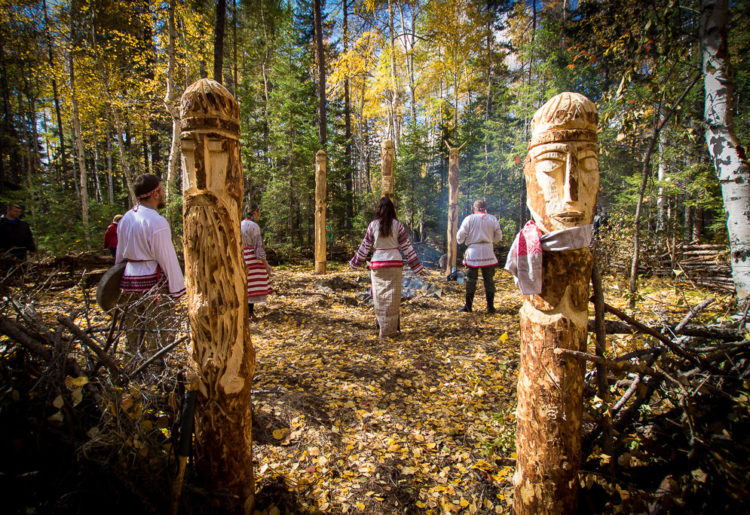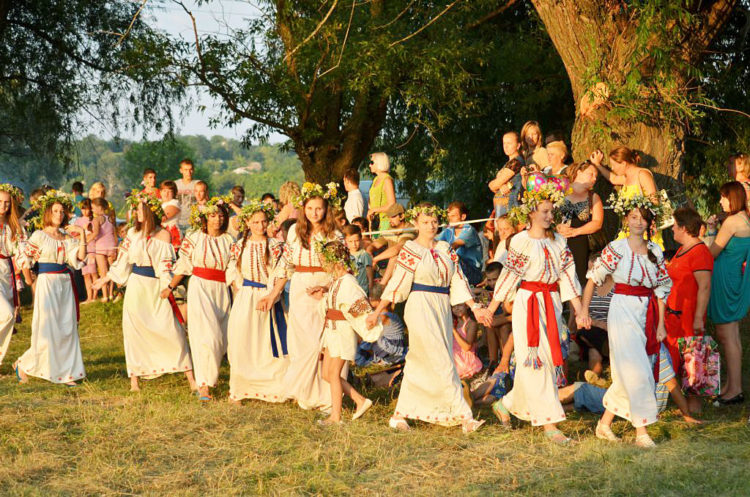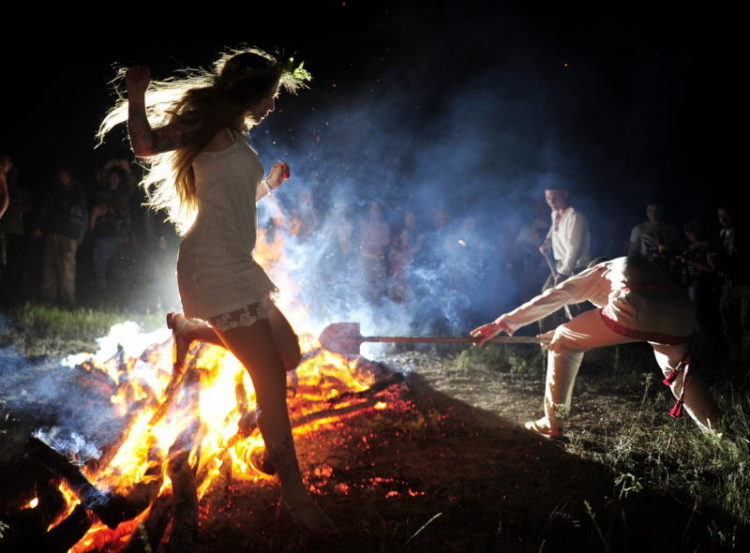Solstice(also solstice) - an astronomical event, the moment the center of the Sun passes through the points of the ecliptic, the most distant from the equator of the celestial sphere and are called solstice points.
Equinox- an astronomical phenomenon when the center of the Sun in its apparent movement along the ecliptic crosses the celestial equator. When the Earth is observed from space on an equinox, the terminator passes along the geographic poles of the Earth and is perpendicular to the earth's equator.
These dates were among the most revered in the pre-Christian period. Solstice, rotation, equinox, solstice - the names of solar holidays, which are also called the four hypostases of the Slavic Dazhdbog, which is the Sun itself - the son of Svarog.
- Kolyada- winter solstice (December 21-22)
- Maslenitsa or Komoyeditsy- the day of the spring equinox (March 21-22)
- Kupailo (Kupala)- summer solstice (June 21-22)
- Radogoshch (Svetovit, Veresen, Tausen)- autumnal equinox (September 22-23)
Kolyada The winter solstice or the longest night of the year. During this period, the young sun Kolyada replaces the old sun Svetovit. Because the daylight hours from this day begins to increase. Replaced by the church on Christmas Day.
Maslenitsa or Komoyeditsy- the day of the spring equinox (day and night are equal in time), farewell to winter, burning of the effigy of Marena, meeting of spring and the Slavic New Year. The date March 21-22 is also the beginning of astronomical spring. From now on, the day becomes longer than the night. Yarilo-Sun replaces Kolyada and drives away Zima-Marena. Traditionally, this circle was celebrated for two whole weeks.
Kupailo- the day of the summer solstice. The longest day and shortest night of the year. The last day of the Rusal Week or Mermaids. Kupala is one of the oldest holidays that has preserved many traditions and customs unchanged to this day, for example: the funeral of Yarila, who is replaced by the God of the summer sun Kupala, the collection of medicinal herbs, the search for a fern flower, etc. Kupailo is also a great holiday, which is now replaced by the church on the birthday of John the Baptist.
Radogoshch(Svetovit, Veresen, Tausen) - the day of the autumn equinox (day and night are equal in time). On this day, the Sun-Old Man Svetovit takes over. The night is getting longer than the day. It is both a solar holiday and a holiday of the end of the harvest. Replaced by the church on the Nativity of the Blessed Virgin Mary.

The position of the sun at the solstice
The periods between solstices are the time when the sun moves either higher above the horizon or lower.
Astronomers note that the movement of a hot star is similar to a sinusoid:
- after the winter solstice it rises daily
- after the summer - on the contrary, it falls lower
The angle created by the sun and the earth's horizon, in other words, the astronomical longitude of a hot star, is:
- 90° in June
- 270° in December
In astronomy, from the moment the Sun enters the zodiac sign of Taurus in June, summer is counted, and winter is counted in the sign of Sagittarius in December. A few days before and after the solstice, the hot celestial body “freezes” at one point at noon.
However, you won't see the sun directly overhead on the solstices.
If you are a resident of the northern hemisphere of the Earth, then:
- go 23.5° above the equator before the summer solstice to see the hot planet vertically above you,
- visit 23.5° south latitude to see a similar phenomenon during the winter solstice.
The position of the sun on the equinoxes
The equinoxes represent a milestone when the sun moves from the northern to the southern hemisphere in autumn and vice versa in spring. This is for the part of our planet that is located above the equator. The sun these days directs its rays in such a way that they evenly heat the entire part of the Earth turned towards it.
Another feature of these calendar dates is that the day before and after, as well as during the equinox, the sun rises clearly in the east and sets in the west. True, this phenomenon is typical only for 23.5 ° north or south latitude. Elsewhere there is a slight shift to the north or south.
Days of equinox and solstice: magic
These 4 days of the year have maximum energy, not only because of the change of times. The Slavs knew this very well and harmoniously built their lives in such a way as to streamline and develop their relationship with nature.
A common moment during the celebrations of all solstices and equinoxes among our ancestors were mass festivities.
The whole village gathered together:
- there were different games and fun
- there were round dances
- everyone ate
- praised the gods
- commemorated ancestors

Everything was fun, easy and natural.
- We still celebrate the summer solstice as Kupala. We are looking for the cherished fern flower in the hope of good luck and the fulfillment of a cherished dream.
- On the autumn equinox, the ancestors held a harvest festival. Adults cleaned the house, yard, and fields. Children decorated their homes with bunches of rowan. It was believed that she would protect the house and its inhabitants from evil all year round.
The winter solstice, or the birth of Kolyada, the young sun, was celebrated on a special scale. There was also a place:
- fortune-telling about the betrothed, marriage, weather for next year, harvest
- caroling and dressing up as animals to scare away dark forces
- jumping over the fire to burn all resentment, envy and similar sins
Three days before and the same after Kolyada had a special power. Mistresses put things in order in their heads and houses, attracted health and well-being to the life of the family. They watched the events of 12 days after Kolyada in order to understand what the coming year would bring for the family.
- The vernal equinox had a special power. Nature was waking up from its winter sleep, a new year was beginning to work on the earth.
- At that time pancakes were baked, there was Maslenitsa. But it lasted 2 weeks - one before, the second after the day of the equinox.
- Housewives baked larks, small birds made from sweet dough.
- In the evening, everyone jumped over the fires to renew themselves for a new round of life. For example, if an unmarried girl jumped, then she will definitely become the mother of a hero.

|
Dates and times of solstices and equinoxes in UTC-0 |
||||||||
|
Equinox |
Solstice |
Equinox |
Solstice |
|||||
| day | time | day | time | day | time | day | time | |
| 2010 | 20 | 17:32 | 21 | 11:28 | 23 | 03:09 | 21 | 23:38 |
| 2011 | 20 | 23:21 | 21 | 17:16 | 23 | 09:04 | 22 | 05:30 |
| 2012 | 20 | 05:14 | 20 | 23:09 | 22 | 14:49 | 21 | 11:12 |
| 2013 | 20 | 11:02 | 21 | 05:04 | 22 | 20:44 | 21 | 17:11 |
| 2014 | 20 | 16:57 | 21 | 10:51 | 23 | 02:29 | 21 | 23:03 |
| 2015 | 20 | 22:45 | 21 | 16:38 | 23 | 08:20 | 22 | 04:48 |
| 2016 | 20 | 04:30 | 20 | 22:34 | 22 | 14:21 | 21 | 10:44 |
| 2017 | 20 | 10:28 | 21 | 04:24 | 22 | 20:02 | 21 | 16:28 |
| 2018 | 20 | 16:15 | 21 | 10:07 | 23 | 01:54 | 21 | 22:23 |
| 2019 | 20 | 21:58 | 21 | 15:54 | 23 | 07:50 | 22 | 04:19 |
| 2020 | 20 | 03:50 | 20 | 21:44 | 22 | 13:31 | 21 | 10:02 |
| 2021 | 20 | 09:37:27 | 21 | 03:32:08 | 22 | 19:21:03 | 21 | 15:59:16 |
| 2022 | 20 | 15:33:23 | 21 | 09:13:49 | 23 | 01:03:40 | 21 | 21:48:10 |
| 2023 | 20 | 21:24:24 | 21 | 14:57:47 | 23 | 06:49:56 | 22 | 03:27:19 |
| 2024 | 20 | 03:06:21 | 20 | 20:50:56 | 22 | 12:43:36 | 21 | 09:20:30 |
| 2025 | 20 | 09:01:25 | 21 | 02:42:11 | 22 | 18:19:16 | 21 | 15:03:01 |







